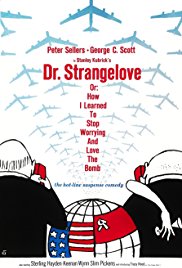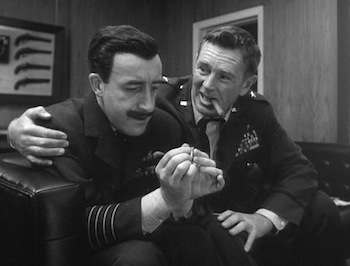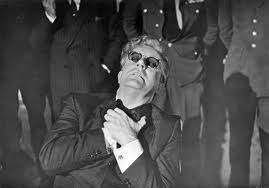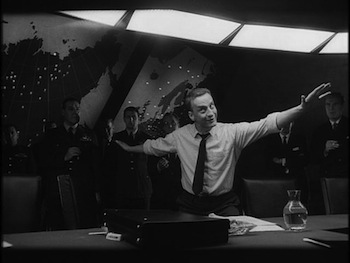Enrichment Worksheets are a TWM innovation containing text and questions designed to get students thinking. Questions are focused on comprehension, application, analysis, syntheses or evaluation. Questions can be answered in class or as homework, as quick writes, journal entries, formal essays, or research papers. The worksheet for Dr. Strangelove contains an introduction to Mutual Assured Destruction which will help students appreciate the film. For a version of the Worksheet in word processing format, click here.
Mutually Assured Destruction and
Dr. Strangelove, Or: How I Learned to Stop Worrying and Love the Bomb
The United States was engaged in a “Cold War” and a nuclear arms race with the Soviet Union from 1946 until shortly before the collapse of the Soviet Union in 1991. By the mid-1960s, each country could destroy the other with nuclear weapons several times over. In both countries, the policy justifying the maintenance of such overwhelming force was that even in the event of a surprise attack, the country attacked would have enough nuclear capacity left to destroy the attacker. The policy was called “deterrence” or “Mutual Assured Destruction” (MAD).
One of the risks that have haunted people since the advent of the nuclear age is the possibility of nuclear war caused by mistake or by a madman. This movie explores the latter possibility.
Question #1: At last report, Russia has 1800 operational nuclear weapons. The U.S. has more than 2000. These numbers are much reduced from what they were at the height of the Cold War. In addition, China has several hundred that could easily be deployed, France has 290 and the United Kingdom has 160. India and Pakistan claim to have nuclear weapons as well. Isreal denies that it has any, but most people believe that it has more than 100 nuclear bombs. Should we be worried about nuclear war, accidental or intentional? What can be done about it?
Dr. Strangelove was made shortly after the October 1962 Cuban Missile Crisis in which the U.S. and the Soviet Union came very close to nuclear war. In the early 1960s, the U.S. began a program to acquire enough long-range nuclear delivery devices to give it an overwhelming advantage over the Soviet Union. By 1962, the U.S. had a four-to-one advantage over the Russians in nuclear missiles. (At the end of the buildup the U.S. had 1000 Minuteman Missiles, 32 Polaris submarines that could deliver 656 warheads, and 600 B-52 bombers which could carry nuclear bombs.)
The Soviet Union had been humiliated in Berlin where it was forced to build a wall to keep East Germans from fleeing to the West. Nikita Khrushchev, the Soviet dictator, thought that President John F. Kennedy was a weak leader who would not respond to the secret placement of intermediate-range missiles in Cuba that could reach most of the U.S. He sought to humiliate the West and redress some of the imbalance in nuclear forces without the necessity of building a large number of long-range delivery devices. The U.S. discovered the scheme and, after a tense thirteen days in which the entire country seemed to hold its breath, forced the Soviets to agree to dismantle the missiles and take them back to Russia. In return, the U.S. guaranteed that it would not invade Cuba in an effort to overthrow Fidel Castro’s communist government. The U.S. also made a secret promise to the Soviets to remove outdated medium-range nuclear missiles from Turkey within six months. The Cuban Missile Crisis was seen as a tremendous victory for the United States and a defeat for Russia.
Question #2: In the 1960s some people built bomb shelters under their houses. Some were equipped with guns and the doors had very strong locks. In case of a nuclear war, would you shoot your neighbors to keep them out of your bomb shelter? Describe the pros and cons.
After the Cuban Missile Crisis, the Soviets were determined never to be caught short again. They embarked on a massive nuclear arms buildup to ensure that they had more than enough ballistic missiles to destroy the U.S.
To further the policy of Mutual Assured Destruction it was important that neither side be able to adequately defend against a nuclear attack. This led to some very strange results. Defensive weapons were seen as destabilizing. Thus, the U.S. and the Soviet Union entered into an anti-ballistic missile treaty in which they agreed to limit the deployment of weapons to defend against a missile attack. Another absurd result was that, in order to prevent either side from developing the capability of destroying the other side’s nuclear deterrent in a first strike, silos for nuclear missiles were hardened so that they could withstand anything except a direct hit, while cities containing millions of people were left totally undefended. While millions were spent on civil defense, everyone knew that the programs would do little to help people in case there was a full-scale nuclear exchange.
During the late 1950s and early 1960s, a number of theoreticians and the media explored the possible effects of nuclear war and the use of nuclear weapons. Edward Teller, a prominent nuclear physicist, was an advocate for developing the hydrogen bomb. Henry Kissinger (later a distinguished U.S. Secretary of State from 1973 – 1977 who won the 1993 Nobel Peace Prize for negotiating an end to the war in Vietnam) suggested that the use of tactical nuclear weapons was an option that decision-makers must consider. Herman Kahn, an author, and Rand Corporation expert, indulged in speculation about the estimated worldwide genetic consequences of fallout from a nuclear war, potential casualties, and even the likelihood of vomiting in fallout shelters after a nuclear blast. Kahn defined the desirable characteristics of a deterrent: frightening, inexorable, persuasive, cheap, non-accident prone, and controllable. (The Dr. Strangelove character is an amalgam of individuals such as the men described above, as well as the prototypical German engineer who worked for the Nazis but after WWII was employed by the U.S. government for his technical expertise.)
The concept of the survivable nuclear war was also discussed in the mass media. A U.S. News and World Report cover article entitled “If Bombs Do Fall” discussed plans to allow people to write checks on their bank even if it had been obliterated in a nuclear attack. Another article in the magazine claimed that the survivors of the U.S. atomic bombing of Japan were doing quite well. Life Magazine also had a cover story with the headline “How You Can Survive Fallout, 97 out of 100 Can Be Saved” advising that the best cure for radiation sickness was hot tea or a solution of baking soda. [The last two paragraphs are adapted from Bibliography Entry #4 in the Supplemental Materials.]
Question #3: Give your opinion on the following statement and explain your reasons: Every dollar that the U.S. spends on its nuclear arsenal is wasted and we have better uses for our money to reduce the deficit or provide education or to give healthcare.
The director, Stanley Kubrick, who also wrote the screenplay, to Dr. Strangelove, Or: How I Learned to Stop Worrying and Love the Bomb had read widely about nuclear arms strategy. He originally intended to make a film that was a serious examination of the risks of nuclear war. However, as he tried to imagine the way things would really happen, ideas came to him which he discarded because they were so ludicrous that people would laugh. After a month or so he realized that the ideas he was throwing out were the best and the most truthful. He then switched the tenor of the film from drama to satire and black humor. It says something about the seriousness of the topic of nuclear war that it is so terrifying that it can only be dealt with by laughing at it and at ourselves.
Black humor expresses the “absurdity, insensitivity, paradox, and cruelty of the modern world.” The novels of such writers as Kurt Vonnegut, Thomas Pynchon, John Barth, Joseph Heller, and Philip Roth also contain elements of black humor. (The Columbia Encyclopedia, Sixth Edition. 2001) Black humor has been described as being “pitched at the breaking point where moral anguish explodes into a mixture of comedy and terror, where things are so bad you might as well laugh.” [Morris Dickstein, Gates of Eden: American Culture in the Sixties (New York, Basic Books, 1977) 92 – 127] Dr. Strangelove is probably the prime example of black humor in the film. Remember, “A nuclear war can ruin your whole day.”





